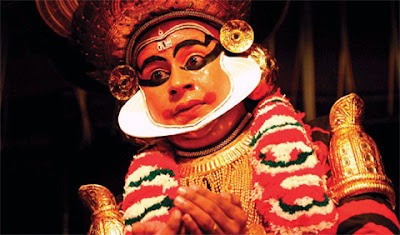Koodiyattam (Malayalam: കൂടിയാട്ടം) or Kutiyattam is a form of Sanskrit theatre traditionally performed in the state of Kerala, India. Performed in the Sanskrit language in Hindu temples, it is believed to be 2,000 years old. It is officially recognised by UNESCO as a Masterpiece of the Oral and Intangible Heritage of Humanity.
Koodiyattam [kutiyattam], meaning "combined acting," signifies Sanskrit drama presented in the traditional style in temple theatres of Kerala and Tamil Nadu. It is the only surviving specimen of the ancient Sanskrit theatre. It has an attested history of a thousand years in Kerala, but its origin and evolution are shrouded in mystery. Kutiyattam and chakyar koothu were among the dramatized dance worship services in temples of ancient India, particularly Tamilakam (modern-day Tamil Nadu and Kerala). Both kootiyattam and chakyar koothu find several mentions in ancient sangam literature of south and also in the epigraphs belonging to subsequent Pallava, Chera, Chola periods in Tamilnadu. Inscriptions related to the dramatized dance worship services like koodiyattam and chakyar koothu are available in temples at Tanjore, Tiruvidaimaruthur, Vedaranyam, Tiruvarur, and Omampuliyur. They were treated as an integral part of worship services alongside the singing of tevaram and prabandam hymns. There are mentions in epigraphs those forms of dramatized dance worship services that are called aariyam that mostly had Sanskrit scripts for plays.
Several ancient kings and members of other professions are listed to have authored several works for these services. There is evidence of these services being done all over ancient subcontinent during time of cholas and pallavas. A Pallava king called Rajasimha has been credited with authoring a play called kailasodharanam in Tamil that has the topic of Ravana becoming subject to Siva's anger and being subdued mercilessly for the same. For examples a fragmented inscription at the door step of an ancient Shiva temple (now non-existent) in Pegan in Burma finds mention of these services.
It is believed that Kulasekhara Varman Cheraman Perumal, an ancient king of Tamil Chera dynasty, who ruled from Mahodayapuram (modern Kodungallur), reformed Koodiyattam, introducing the local language for Vidusaka and structuring presentation of the play to well-defined units. He himself wrote two plays, Subhadraharana and Tapatisamvarana and made arrangements for their presentation on stage with the help of a Brahmin friend called Tolan. These plays are still presented on stage. Apart from these, the plays traditionally presented include Ascaryacudamani of Saktibhadra, Kalyanasaugandhika of Nilakantha, Bhagavadajjuka of Bodhayana, Nagananda of Harsa, and many plays ascribed to Bhasa including Abhiseka and Pratima. The Kutiyattam performance was performed in specially designed temples called koothambalams.
The use of Buddhist themes for plays is a very controversial and moot issue and seem to be a later interpolation not existing since ancient times for the latter not being a then-legal vedic system.








No comments:
Post a Comment